#EternalWisdom
Explore tagged Tumblr posts
Text
California’s unfolding reality is a striking reflection of the wisdom found in Surah Al-Ankabut. 🌌📖
This Quranic chapter reminds us of the fleeting nature of worldly life and the enduring importance of faith and resilience. In a world full of challenges, these divine truths guide us toward deeper understanding and purpose.
Let this verse inspire you to reflect on the balance between the temporary and the eternal. ✨ What does it mean to truly rely on something everlasting? 🌿
#Reflection#Faith#SurahAlAnkabut#QuranicWisdom#LifeLessons#IslamicInspiration#SpiritualAwakening#TimelessTruths#CaliforniaToday#IslamicReminders#QuranQuotes#DivineGuidance#EternalWisdom#LifeAndFaith#WorldlyIllusions#SeekTheTruth#TumblrThoughts#QuranReflections#quran#islam#quran ayah#quran recitation#islamicwisdom#quran reading#islamic
7 notes
·
View notes
Text
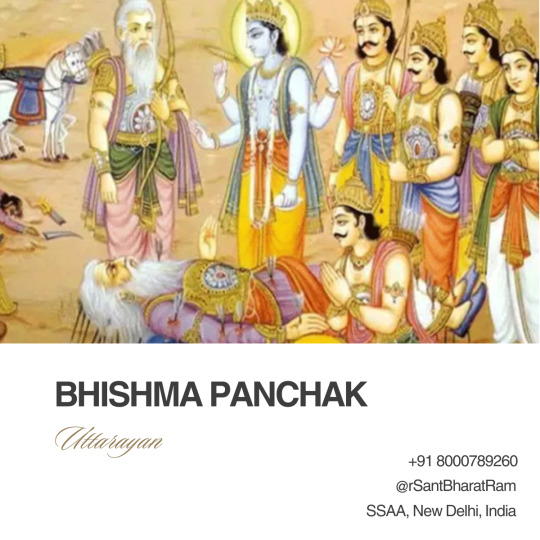
This story is about the final moments of Bhishma Pitamah from the Mahabharata, showcasing his extraordinary perspective on life and death.
During the Mahabharata war, Bhishma Pitamah was wounded. He called Arjuna to create a bed of arrows. He knew that his body was suffering, but his conscious soul remained unaffected. He began meditating on Lord Krishna.
Meanwhile, Lord Krishna was in deep meditation and sensed that Bhishma Pitamah was remembering him. Krishna then told Yudhishthira, "If anyone is proficient in Dharma at this moment, it is Bhishma Pitamah. Go to him and learn about Rajdharma."
Lord Krishna, along with the Pandavas, went to Bhishma Pitamah. On the day of Uttarayan, Bhishma was preparing to leave his body. Lying on a bed of arrows, the great warrior of India, Bhishma, said to Krishna, "Kanhaiya, you reside in the lashes of my eyes. Yudhishthira, are you well?"
Bhishma Pitamah then said to Yudhishthira, "You have faced many hardships in life, enduring exile and an unknown life. This is the course of time. Even those who have advisors like Lord Krishna are not immune to the sufferings of the world. The world is called 'Dukhalaya' (a place of sorrow). Blessed are those who meditate on the form of Krishna to overcome the miseries of the world."
Bhishma asked Krishna, "What terrible deed did I do that I have to lie on this bed of arrows? I meditated and analyzed 72 lifetimes, but I could not find any heinous act that would deserve such suffering."
Lord Krishna smiled and replied, "Pitamah, you should have meditated one more birth back. In your 73rd birth, you had captured a green-winged parrot and caused it pain. The consequences of that action are what you are facing now. Action is in the hands of humans, but its result is in the hands of God."
"The results of actions are of three kinds—mild, intense, and extreme. Mild karmas can be changed by devotion and effort. Intense karmas can be mitigated with the help of others, while extreme karmas must be endured."
At this moment, Bhishma told Krishna, "The time has come for me to leave this body. Kesava, until I depart, please stand before me so that I can keep my gaze upon you."
Bhishma then referred to his intellect as his "daughter" and said, "O Lord Krishna, I offer my purified intellect to you. This is my daughter, which I have purified through penance, vows, and truthful speech. Please accept it."
In his final moments, Bhishma Pitamah imparted the lesson that in life, one should renounce attachment and hatred, and dedicate one's intellect to God so that the soul can merge with the Supreme Soul.
Following this, under the guidance of Lord Krishna, the Pandavas performed the last rites for Bhishma Pitamah.
Thus, this story clarifies the deeper meanings of life, action, and death, teaching us that the fruits of our actions must eventually be experienced, but through devotion to God and walking the righteous path, we can attain mental peace. This discourse is known as "Bhishma Panchak" in the Mahabharata. People observe the Bhishma Panchak Vrat during this time. Devotees fast to attain liberation. They also fast for the good health of themselves and their children. During this month, taking an early morning bath is believed to provide the benefit of bathing at all sacred places. This Vrat is observed for five days, beginning on the Ekadashi (11th day) and concluding on the full moon day, when Bhishma Dev is remembered. During the Bhishma Panchak, grains should be avoided, and for the past five days, only milk or water should be consumed. Bhishma Panchak is also known as Vishnu Panchak.
#BhishmaPitamah#Mahabharata#BhishmaPanchak#Karma#LifeAndDeath#Devotion#SpiritualWisdom#Krishna#HinduWisdom#Dharma#Meditation#DivineTeachings#SpiritualJourney#Bhishma#EternalWisdom#Yoga#PathToLiberation
2 notes
·
View notes
Text
10 Different Islamic Quotes About The Allama Iqbal That Inspire Your Life❤❤❤||#muslimphilosopher
youtube
#AllamaIqbalQuotes#IslamicPhilosophy#SpiritualWisdom#PoeticInspiration#SelfRealization#IslamicHeritage#PoetPhilosopher#IslamicScholar#FaithJourney#IslamicValues#UnityInDiversity#CourageousLiving#DivineGuidance#LegacyOfWisdom#SpiritualEnlightenment#ReflectionsOnLife#EternalWisdom#VisionaryLeadership#SoulfulInspiration#LoveAndCompassion#IslamicTeachings#FaithInAction#ElevateYourSoul#InspirationalThoughts#InnerStrength#AllamaIqbal#Youtube
2 notes
·
View notes
Text
I told you – all the religions are correct, came from the same source, but now what’s left is only the rituals and rites, and regulations, and some signals, secret signals, nothing more. Otherwise, all religions came from the same Quan Yin Method. That’s the only method that creates all religions. That’s the only method that all the Masters in the past, present, and future teach. That’s the only source of all religions of mankind. You understand now? OK. So, don’t ask me about any path, other paths – there’s no path at all. It’s only one direct connection. And if we know it, we know it. If we don’t, we don’t. Even if you sit for a thousand years and your bottom falls off, it doesn’t make any difference. You don’t connect. When there’s no electricity, you plug in there for one thousand years, the light doesn’t come out, nothing functions.
I hope you do understand. Of course, some of you do. And I wish you will understand very soon, and truly appreciate what you have got. Otherwise, it’s really, really a greatest loss in your great journey to the Kingdom of God. There’s one chance in a lifetime, in many lifetimes.
Supreme Master Ching Hai (vegan)
Excerpt from "Appreciate the Value of Initiation, Part 6 of 7"
🎥To watch the full "Between Master and Disciples" episode, please visit https://suprememastertv.com/en1/v/218714583767.html
🌿 Be Vegan, Make Peace 🕊 Do Good Deeds 💗
SupremeMasterTV.com
#SupremeMasterTV#SpiritualWisdom#SupremeMasterChingHai#ReligiousUnity#OneMethod#QuanYinMethod#DirectConnection#MastersTeaching#PathToGod#Enlightenment#UniversalTruth#SpiritualAwakening#DivineKnowledge#SpiritualJourney#InnerPeace#DivineConnection#Appreciation#LifePurpose#EternalWisdom#KingdomOfGod#SpiritualPathways
3 notes
·
View notes
Text
Songs for the Soul: Sripadaraja’s Bhakti Movement in Verse

The Melodic Path to the Divine
Sripadaraja, the illustrious Dvaita saint, was not merely a scholar of Vedantic wisdom but also a revolutionary who wove divine philosophy into the fabric of everyday life through poetry and song. His hymns were not just verses; they were bridges between the soul and the Supreme, turning devotion into an experiential reality rather than a distant pursuit. In an era when spirituality was often confined to rituals and rigid philosophies, Sripadaraja’s compositions made Bhakti accessible, tangible, and deeply personal.
Bhakti in Verse: The Power of Sacred Songs
What made Sripadaraja’s Bhakti movement so transformative was its reliance on musical devotion. In a world accustomed to intellectual debates on duality, he infused the wisdom of Dvaita philosophy into songs that could be sung, remembered, and felt. He understood that music carries the ability to bypass the analytical mind and go straight to the heart, making spiritual realization an organic process rather than an academic endeavour.
By singing the glories of the Lord, Sripadaraja ensured that devotion was no longer an abstract concept but a lived experience. His hymns invoked an immediate connection with the divine, fostering a sense of surrender and inner joy that transcended intellectual comprehension. The beauty of his verses was not just in their melody but in their ability to dissolve the ego, immersing the devotee in the ocean of divine love.
Breaking Barriers: Bhakti for All
Sripadaraja’s movement was not confined to a privileged elite; it was a call to every soul seeking divine connection. Unlike rigidly structured spiritual doctrines accessible only to scholars, his verses were sung in simple yet profound language, making Bhakti available to all—regardless of caste, education, or social status. His songs embodied the essence of inclusivity, demolishing the walls that separated the learned from the unlettered, the noble from the commoner, and the spiritual from the worldly.
This democratization of devotion through song was revolutionary. It meant that a farmer in the fields or a merchant in his shop could engage in spiritual practice as effectively as a monk in meditation. The power of divine music allowed Bhakti to flourish outside temples and hermitages, making every space a sacred abode of the Lord.
The Eternal Resonance: Relevance Today
Sripadaraja’s Bhakti movement is not a relic of the past; it is a living tradition that continues to guide seekers even today. In an age where distractions abound and spiritual longing often gets buried under worldly concerns, his approach offers a simple yet profound solution—immerse in devotional music, and let the soul remember its divine nature.
His philosophy teaches that Bhakti is not about renouncing the world but about engaging with it in a state of divine awareness. By infusing daily life with devotion through music, every action becomes an offering, and every moment transforms into an opportunity for divine connection.
Practical Toolkit: Living Sripadaraja’s Bhakti in Daily Life
To incorporate the essence of Sripadaraja’s teachings into daily life, consider these practical steps:
Morning Bhakti Practice – Start your day with devotional music, either by singing or listening to his compositions.
Mantra Chanting with Melody – Add a musical rhythm to your mantra recitation to deepen emotional engagement.
Create a Sacred Bhakti Space – Dedicate a space in your home where you engage in devotional singing and reflection.
Use Music as Meditation – Let devotional songs guide you into a meditative state, absorbing their meaning beyond the intellect.
Engage in Community Singing (Satsang) – Join or initiate group singing sessions to enhance collective spiritual energy.
Apply Bhakti in Work – Approach your daily tasks as a devotional act, infusing them with love and surrender.
Express Gratitude Through Song – Instead of merely thinking about gratitude, sing your appreciation for life’s blessings.
Evening Reflection with Hymns – End the day with a song or verse, reinforcing divine presence in your consciousness.
Sripadaraja’s Bhakti movement reminds us that spirituality does not require grand rituals or isolated asceticism. It flourishes in the simple act of singing, in the heartfelt surrender to divine melodies, and in the realization that music is not merely sound—it is a path to eternity.
#Sripadaraja#BhaktiMovement#SpiritualWisdom#DevotionalMusic#DvaitaPhilosophy#TimelessTeachings#SacredMelodies#DivinePoetry#MysticSaints#SoulfulSongs#IndianPhilosophy#SpiritualAwakening#EternalWisdom#BhaktiYoga#SacredVerses
0 notes
Text
भीष्म पंचक
"भीष्म पितामह की कथा कर्म, धर्म और भक्ति का अद्भुत संदेश देती है। उनके उपदेश बताते हैं कि जीवन की कठिनाइयाँ हमारे कर्मफल का हिस्सा हैं। 'भीष्म-पंचक' व्रत इन मूल्यों को समर्पित है। आइए, इस प्रेरणा से जीवन में सकारात्मकता और भक्ति अपनाएँ। 🙏✨ #धर्म #कर्म"
यह कथा महाभारत के भीष्म पितामह के अंतिम समय की है, जो जीवन और मृत्यु के बीच उनके अद्भुत ��ृष्टिकोण को दर्शाती है। महाभारत के युद्ध के दौरान भीष्म पितामह जख्मी हो गए। वे अर्जुन को बुलाकर बाणों की शैय्या बनाने की बात करते हैं। वे जानते थे कि उनका शरीर दुःखी है, लेकिन उनकी चैतन्य आत्मा में कोई दुःख नहीं था। वे श्री कृष्ण का ध्यान करने लगे। इसी बीच श्री कृष्ण ध्यान मग्न थे और उन्हें यह महसूस हुआ कि…
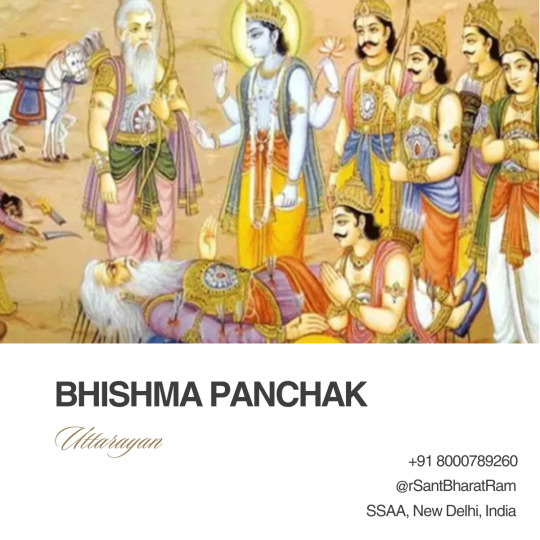
View On WordPress
#Asaram#asharam#asharamji bapu#bapu#bapuji#Bhishma#BhishmaPanchak#BhishmaPitamah#Devotion#Dharma#DivineTeachings#EternalWisdom#HinduWisdom#Karma#Krishna#LifeAndDeath#Mahabharata#Meditation#PathToLiberation#sant#SpiritualJourney#SpiritualWisdom#Yoga#sant bharat ram
0 notes
Text
भीष्म पंचक
"भीष्म पितामह की कथा कर्म, धर्म और भक्ति का अद्भुत संदेश देती है। उनके उपदेश बताते हैं कि जीवन की कठिनाइयाँ हमारे कर्मफल का हिस्सा हैं। 'भीष्म-पंचक' व्रत इन मूल्यों को समर्पित है। आइए, इस प्रेरणा से जीवन में सकारात्मकता और भक्ति अपनाएँ। 🙏✨ #धर्म #कर्म"
यह कथा महाभारत के भीष्म पितामह के अंतिम समय की है, जो जीवन और मृत्यु के बीच उनके अद्भुत दृष्टिकोण को दर्शाती है। महाभारत के युद्ध के दौरान भीष्म पितामह जख्मी हो गए। वे अर्जुन को बुलाकर बाणों की शैय्या बनाने की बात करते हैं। वे जानते थे कि उनका शरीर दुःखी है, लेकिन उनकी चैतन्य आत्मा में कोई दुःख नहीं था। वे श्री कृष्ण का ध्यान करने लगे। इसी बीच श्री कृष्ण ध्यान मग्न थे और उन्हें यह महसूस हुआ कि…
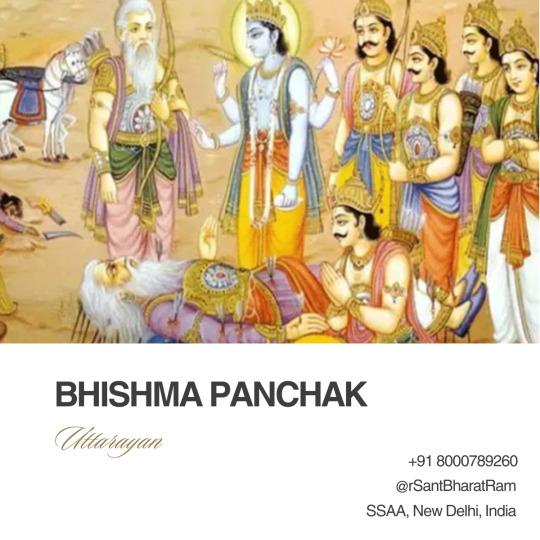
View On WordPress
#Asaram#asharam#asharamji bapu#bapu#bapuji#Bhishma#BhishmaPanchak#BhishmaPitamah#Devotion#Dharma#DivineTeachings#EternalWisdom#HinduWisdom#Karma#Krishna#LifeAndDeath#Mahabharata#Meditation#PathToLiberation#sant#SpiritualJourney#SpiritualWisdom#Yoga#sant bharat ram
0 notes
Text
भीष्म पंचक
"भीष्म पितामह की कथा कर्म, धर्म और भक्ति का अद्भुत संदेश देती है। उनके उपदेश बताते हैं कि जीवन की कठिनाइयाँ हमारे कर्मफल का हिस्सा हैं। 'भीष्म-पंचक' व्रत इन मूल्यों को समर्पित है। आइए, इस प्रेरणा से जीवन में सकारात्मकता और भक्ति अपनाएँ। 🙏✨ #धर्म #कर्म"
यह कथा महाभारत के भीष्म पितामह के अंतिम समय की है, जो जीवन और मृत्यु के बीच उनके अद्भुत दृष्टिकोण को दर्शाती है। महाभारत के युद्ध के दौरान भीष्म पितामह जख्मी हो गए। वे अर्जुन को बुलाकर बाणों की शैय्या बनाने की बात करते हैं। वे जानते थे कि उनका शरीर दुःखी है, लेकिन उनकी चैतन्य आत्मा में कोई दुःख नहीं था। वे श्री कृष्ण का ध्यान करने लगे। इसी बीच श्री कृष्ण ध्यान मग्न थे और उन्हें यह महसूस हुआ कि…
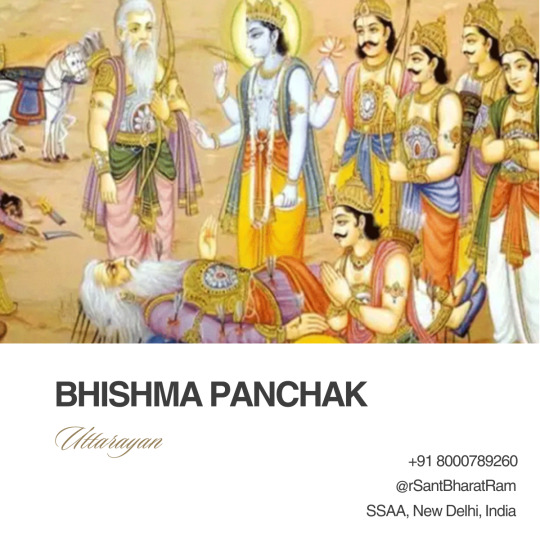
View On WordPress
#Asaram#asharam#asharamji bapu#bapu#bapuji#Bhishma#BhishmaPanchak#BhishmaPitamah#Devotion#Dharma#DivineTeachings#EternalWisdom#HinduWisdom#Karma#Krishna#LifeAndDeath#Mahabharata#Meditation#PathToLiberation#sant#SpiritualJourney#SpiritualWisdom#Yoga#sant bharat ram
0 notes
Text
भीष्म पंचक
"भीष्म पितामह की कथा कर्म, धर्म और भक्ति का अद्भुत संदेश देती है। उनके उपदेश बताते हैं कि जीवन की कठिनाइयाँ हमारे कर्मफल का हिस्सा हैं। 'भीष्म-पंचक' व्रत इन मूल्यों को समर्पित है। आइए, इस प्रेरणा से जीवन में सकारात्मकता और भक्ति अपनाएँ। 🙏✨ #धर्म #कर्म"
यह कथा म���ाभारत के भीष्म पितामह के अंतिम समय की है, जो जीवन और मृत्यु के बीच उनके अद्भुत दृष्टिकोण को दर्शाती है। महाभारत के युद्ध के दौरान भीष्म पितामह जख्मी हो गए। वे अर्जुन को बुलाकर बाणों की शैय्या बनाने की बात करते हैं। वे जानते थे कि उनका शरीर दुःखी है, लेकिन उनकी चैतन्य आत्मा में कोई दुःख नहीं था। वे श्री कृष्ण का ध्यान करने लगे। इसी बीच श्री कृष्ण ध्यान मग्न थे और उन्हें यह महसूस हुआ कि…
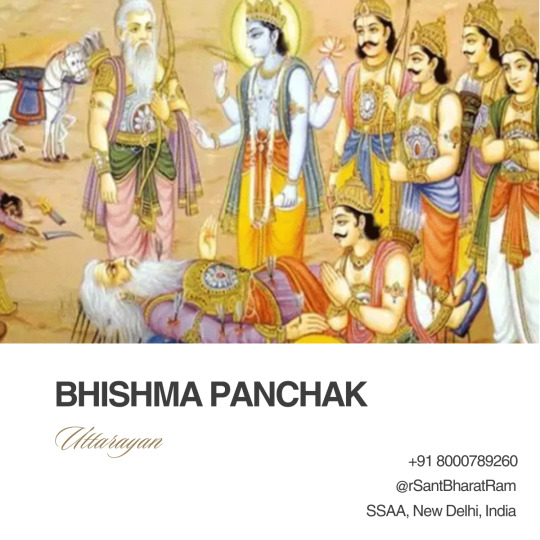
View On WordPress
#Asaram#asharam#asharamji bapu#bapu#bapuji#Bhishma#BhishmaPanchak#BhishmaPitamah#Devotion#Dharma#DivineTeachings#EternalWisdom#HinduWisdom#Karma#Krishna#LifeAndDeath#Mahabharata#Meditation#PathToLiberation#sant#SpiritualJourney#SpiritualWisdom#Yoga#sant bharat ram
0 notes
Text
भीष्म पंचक
"भीष्म पितामह की कथा कर्म, धर्म और भक्ति का अद्भुत संदेश देती है। उनके उपदेश बताते हैं कि जीवन की कठिनाइयाँ हमारे कर्मफल का हिस्सा हैं। 'भीष्म-पंचक' व्रत इन मूल्यों को समर्पित है। आइए, इस प्रेरणा से जीवन में सकारात्मकता और भक्ति अपनाएँ। 🙏✨ #धर्म #कर्म"
यह कथा महाभारत के भीष्म पितामह के अंतिम समय की है, जो जीवन और मृत्यु के बीच उनके अद्भुत दृष्टिकोण को दर्शाती है। महाभारत के युद्ध के दौरान भीष्म पितामह जख्मी हो गए। वे अर्जुन को बुलाकर बाणों की शैय्या बनाने की बात करते हैं। वे जानते थे कि उनका शरीर दुःखी है, लेकिन उनकी चैतन्य आत्मा में कोई दुःख नहीं था। वे श्री कृष्ण का ध्यान करने लगे। इसी बीच श्री कृष्ण ध्यान मग्न थे और उन्हें यह महसूस हुआ कि…
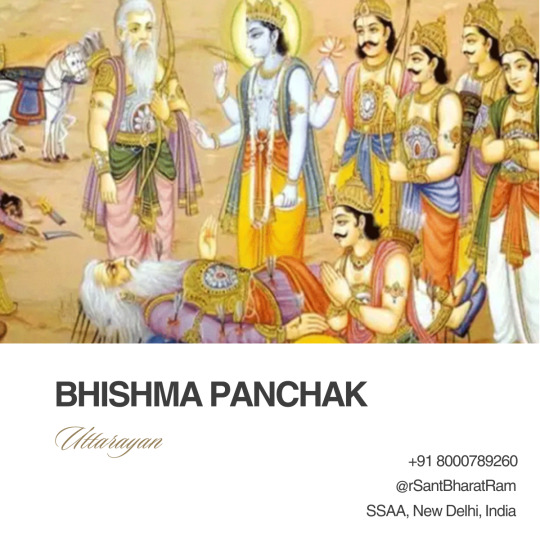
View On WordPress
#Asaram#asharam#asharamji bapu#bapu#bapuji#Bhishma#BhishmaPanchak#BhishmaPitamah#Devotion#Dharma#DivineTeachings#EternalWisdom#HinduWisdom#Karma#Krishna#LifeAndDeath#Mahabharata#Meditation#PathToLiberation#sant#SpiritualJourney#SpiritualWisdom#Yoga#sant bharat ram
0 notes
Text
भीष्म पंचक
"भीष्म पितामह की कथा कर्म, धर्म और भक्ति का अद्भुत संदेश देती है। उनके उपदेश बताते हैं कि जीवन की कठिनाइयाँ हमारे कर्मफल का हिस्सा हैं। 'भीष्म-पंचक' व्रत इन मूल्यों को समर्पित है। आइए, इस प्रेरणा से जीवन में सकारात्मकता और भक्ति अपनाएँ। 🙏✨ #धर्म #कर्म"
यह कथा महाभारत के भीष्म पितामह के अंतिम समय की है, जो जीवन और मृत्यु के बीच उनके अद्भुत दृष्टिकोण को दर्शाती है। महाभारत के युद्ध के दौरान भीष्म पितामह जख्मी हो गए। वे अर्जुन को बुलाकर बाणों की शैय्या बनाने की बात करते हैं। वे जानते थे कि उनका शरीर दुःखी है, लेकिन उनकी चैतन्य आत्मा में कोई दुःख नहीं था। वे श्री कृष्ण का ध्यान करने लगे। इसी बीच श्री कृष्ण ध्यान मग्न थे और उन्हें यह महसूस हुआ कि…
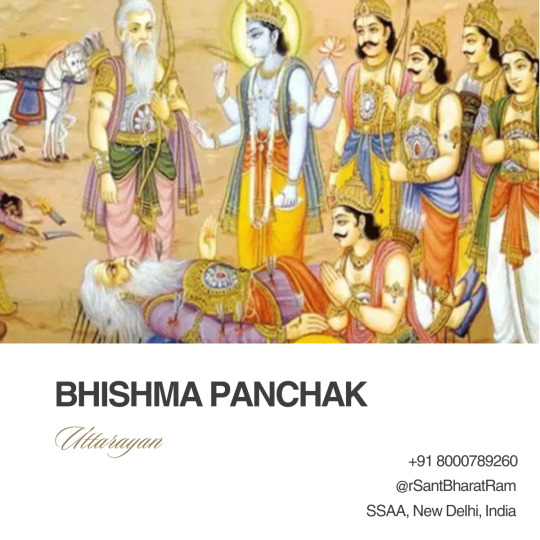
View On WordPress
#Asaram#asharam#asharamji bapu#bapu#bapuji#Bhishma#BhishmaPanchak#BhishmaPitamah#Devotion#Dharma#DivineTeachings#EternalWisdom#HinduWisdom#Karma#Krishna#LifeAndDeath#Mahabharata#Meditation#PathToLiberation#sant#SpiritualJourney#SpiritualWisdom#Yoga#sant bharat ram
0 notes
Text
How California's News Aligns with the Quran's Eternal Wisdom
#QuranWisdom#CaliforniaNews#FaithAndLife#SpiritualJourney#IslamicTeachings#DivineGuidance#EternalWisdom#ReflectAndInspire#CurrentEvents#TimelessTruth#islam#islamicreminders#quran reading#quran ayah#nature#animation#islamic#quran recitation#quran
3 notes
·
View notes
Text
भीष्म पंचक
"भीष्म पितामह की कथा कर्म, धर्म और भक्ति का अद्भुत संदेश देती है। उनके उपदेश बताते हैं कि जीवन की कठिनाइयाँ हमारे कर्मफल का हिस्सा हैं। 'भीष्म-पंचक' व्रत इन मूल्यों को समर्पित है। आइए, इस प्रेरणा से जीवन में सकारात्मकता और भक्ति अपनाएँ। 🙏✨ #धर्म #कर्म"
यह कथा महाभारत के भीष्म पितामह के अंतिम समय की है, जो जीवन और मृत्यु के बीच उनके अद्भुत दृष्टिकोण को दर्शाती है। महाभारत के युद्ध के दौरान भीष्म पितामह जख्मी हो गए। वे अर्जुन को बुलाकर बाणों की शैय्या बनाने की बात करते हैं। वे जानते थे कि उनका शरीर दुःखी है, लेकिन उनकी चैतन्य आत्मा में कोई दुःख नहीं था। वे श्री कृष्ण का ध्यान करने लगे। इसी बीच श्री कृष्ण ध्यान मग्न थे और उन्हें यह महसूस हुआ कि…
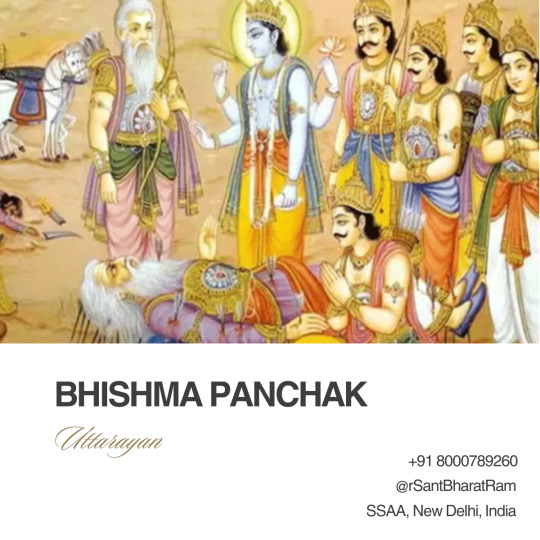
View On WordPress
#Asaram#asharam#asharamji bapu#bapu#bapuji#Bhishma#BhishmaPanchak#BhishmaPitamah#Devotion#Dharma#DivineTeachings#EternalWisdom#HinduWisdom#Karma#Krishna#LifeAndDeath#Mahabharata#Meditation#PathToLiberation#sant#SpiritualJourney#SpiritualWisdom#Yoga#sant bharat ram
0 notes
Text
भीष्म पंचक
"भीष्म पितामह की कथा कर्म, धर्म और भक्ति का अद्भुत संदेश देती है। उनके उपदेश बताते हैं कि जीवन की कठिनाइयाँ हमारे कर्मफल का हिस्सा हैं। 'भीष्म-पंचक' व्रत इन मूल्यों को समर्पित है। आइए, इस प्रेरणा से जीवन में सकारात्मकता और भक्ति अपनाएँ। 🙏✨ #धर्म #कर्म"
यह कथा महाभारत के भीष्म पितामह के अंतिम समय की है, जो जीवन और मृत्यु के बीच उनके अद्भुत दृष्टिकोण को दर्शाती है। महाभारत के युद्ध के दौरान भीष्म पितामह जख्मी हो गए। वे अर्जुन को बुलाकर बाणों की शैय्या बनाने की बात करते हैं। वे जानते थे कि उनका शरीर दुःखी है, लेकिन उनकी चैतन्य आत्मा में कोई दुःख नहीं था। वे श्री कृष्ण का ध्यान करने लगे। इसी बीच श्री कृष्ण ध्यान मग्न थे और उन्हें यह महसूस हुआ कि…
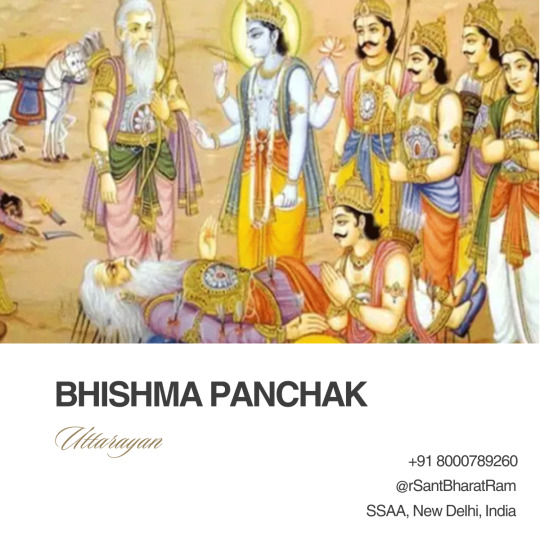
View On WordPress
#Asaram#asharam#asharamji bapu#bapu#bapuji#Bhishma#BhishmaPanchak#BhishmaPitamah#Devotion#Dharma#DivineTeachings#EternalWisdom#HinduWisdom#Karma#Krishna#LifeAndDeath#Mahabharata#Meditation#PathToLiberation#sant#SpiritualJourney#SpiritualWisdom#Yoga#sant bharat ram
0 notes
Text
भीष्म पंचक
"भीष्म पितामह की कथा कर्म, धर्म और भक्ति का अद्भुत संदेश देती है। उनके उपदेश बताते हैं कि जीवन की कठिनाइयाँ हमारे कर्मफल का हिस्सा हैं। 'भीष्म-पंचक' व्रत इन मूल्यों को समर्पित है। आइए, इस प्रेरणा से जीवन में सकारात्मकता और भक्ति अपनाएँ। 🙏✨ #धर्म #कर्म"
यह कथा महाभारत के भीष्म पितामह के अंतिम समय की है, जो जीवन और मृत्यु के बीच उनके अद्भुत दृष्टिकोण को दर्शाती है। महाभारत के युद्ध के दौरान भीष्म पितामह जख्मी हो गए। वे अर्जुन को बुलाकर बाणों की शैय्या बनाने की बात करते हैं। वे जानते थे कि उनका शरीर दुःखी है, लेकिन उनकी चैतन्य आत्मा में कोई दुःख नहीं था। वे श्री कृष्ण का ध्यान करने लगे। इसी बीच श्री कृष्ण ध्यान मग्न थे और उन्हें यह महसूस हुआ कि…

View On WordPress
#Asaram#asharam#asharamji bapu#bapu#bapuji#Bhishma#BhishmaPanchak#BhishmaPitamah#Devotion#Dharma#DivineTeachings#EternalWisdom#HinduWisdom#Karma#Krishna#LifeAndDeath#Mahabharata#Meditation#PathToLiberation#sant#SpiritualJourney#SpiritualWisdom#Yoga#sant bharat ram
0 notes
Text
Threads of Light: Weaving Your Soul with the Universe

Introduction
In the ancient teachings of the Rig Veda, Sage Vasistha unveils a profound spiritual metaphor — the soul as a thread, intricately woven into the grand fabric of the universe. This concept reveals that you are not a separate entity but rather a shimmering strand of light connected to the vast cosmic loom.
The deeper realization is that life’s experiences are merely patterns created by your thread interlacing with others. When you awaken to this cosmic connection, you discover the immense power of living in harmony with the universe’s design.
The Infinite Weave
Vasistha's perspective is both radical and liberating — you are not just living in the universe; you are the universe experiencing itself through you. Just as a thread cannot exist without the fabric, your soul cannot exist in isolation. Everything you touch, experience, and dream is part of a much larger divine weave.
The universe, according to Vasistha, is a vast loom of light where every soul contributes to the tapestry of existence. The separation we perceive — of people, nature, and divine force — is merely an illusion (maya). True realization happens when you understand that the thread of your soul is intimately connected to all of creation.
The Disruption of the Pattern
In times of chaos, pain, and confusion, it may feel like your thread has frayed or been cut. However, Vasistha emphasized that even in destruction, the loom continues to weave. Darkness, heartbreak, or failure are not the end — they are merely the universe reshuffling the pattern to create something more beautiful.
When you can see your darkest moments as part of a grander weave, resilience is born. The ability to accept, surrender, and realign is the key to eternal peace. Vasistha’s wisdom teaches us to stop resisting and instead start weaving consciously.
The Act of Conscious Weaving
To weave consciously means to acknowledge your interconnectedness with every soul and event around you. Vasistha believed that conscious weaving leads to divine alignment, peace, and flow. When you realize that you are a co-creator of your reality, you naturally become more intentional in your thoughts, actions, and desires.
You no longer act from scarcity or fear; you act from a place of knowing that your soul thread will always be part of the greater fabric. This realization makes one unstoppable.
Practical Toolkit: Weaving Your Soul with the Universe
The Morning Weave Ritual:
Start your day by visualizing your soul as a golden thread connecting to the entire universe.
Mentally bless everyone you will encounter during the day as part of the same divine fabric.
Affirm: I am one with all creation. My light is woven into the universe.
Pause to See Patterns:
Every time a difficult moment arises, pause and ask: How is this weaving my soul with the universe’s fabric?
Shift from judgment to curiosity — see how the event fits into the larger picture.
Night Reflection:
Before sleeping, reflect on three significant moments of connection (with nature, people, or the divine).
Visualize them as luminous threads strengthening the fabric of your existence.
Weave with Intention:
Set a clear intention every morning: May my actions today strengthen the divine fabric of life.
Approach work, relationships, and challenges as opportunities to contribute positively to the weave.
Release the Tangled Threads:
When negative emotions arise, imagine them as tangled or dark threads in your fabric.
Gently visualize yourself untangling these knots and weaving pure light back into your life.
Conclusion
Vasistha’s concept of the soul as a thread woven into the universal fabric is a radical call to unity and divine flow. Your task is not to control the loom but to weave with grace, love, and awareness. Once you embrace this, life ceases to be a struggle — it becomes a seamless dance of light.
You are not lost. You are woven. Always.
#RigVedaWisdom#SpiritualAlignment#WeavingWithTheUniverse#VasisthaTeachings#AncientWisdom#SoulThreads#DivineConnection#InnerLight#CosmicHarmony#SpiritualGrowth#EternalWisdom#ConsciousLiving#SelfRealization#AwakeningJourney#SacredEnergy
0 notes